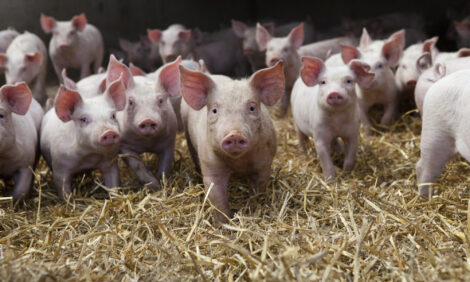



50 More Years of Breeding Excellence
Dr Grant Walling, Research and Genetics Director for JSR Genetics, looked into his crystal ball and gave his predictions concerning genetic progress in the next five decades. He gave the presentation at the company's 19th Annual Technical Conference, which marked the 50th anniversary of the founding of JSR Genetics.Dr Walling opened his presentation by citing the examples of BSE/CJD and bird flu mentioned in previous conferences. "Sensationalism is destroying science," he said.
Comparing performance of pigs in the 1960s - when JSR was founded - with the top-performing hers today, he highlighted the tremendous changes in pig breeding since JSR was founded in 1958.
Past Improvements
| Table 1. Genetic Progress: 1960s versus Modern Average versus Top-Performing Herds | ||||
|---|---|---|---|---|
| Parameter | 1960s | Modern Average | Top JSR Herds | % Change |
| Pigs weaned per sow | 14 | 21 | 28.4 | 103 |
| Lean % | 40 | 55 | 64.7 | 62 |
| Feed conversion ratio (FCR) | 3.0 | 2.2 | 2.2 | 27 |
| Lean meat (kg) per tonne feed | 85 | 170 | 200 | 135 |
These past improvements are the result of great strides in genetic improvement, which have been cumulative, permanent and sustainable. Dr Walling showed examples of the steady rise over the years in the number of piglets born alive (Genepacker 90) as well as the growth rate and lean meat percentage of the slaughter pig.
Crossbreeding has also helped boost performance, i.e. heterosis, by combining breeds with desirable characteristics. The largest benefits are achieved in reproduction but there have also been benefits to growth and disease resistance.
Thirdly, as an example of improving technology, Dr Walling showed how the move from Meritronics to the Aloka scanner and then CT scanning has progressively raised the accuracy of predicting carcass composition.
Future Progress and Barriers
| Table 2. Future Predictions from Genetic Progress | ||||
|---|---|---|---|---|
| Parameter | 2000s | 2050 | Top JSR Herds 2008 | |
| Pigs weaned per sow | 21 | 28 | 28.4 | |
| Lean % | 55 | 62.2 | 64.7 | |
| Feed conversion ratio (FCR) | 2.2 | 1.9 | 2.2 | |
| Lean meat (kg) per tonne feed | 170 | 234 | 200 | |
Table 2 demonstrates that in most parameters, JSR's best herds currently achieve levels above those predicted for 2050. These will be achieved by more farms with modern conditions and facilities and a strong commitment to training staff.
New Technologies

Genomics allows breeders to address new traits without genetic modification. There is a new method of DNA collection, which allows a drop of blood to be put onto a card and stored at room temperature. This technique could be used to help reduce boar taint and improve disease resistance and meat eating quality. The cost - at £120 per animal - is currently prohibitive on a large scale.
The new technology highlights an inherent problem: costs are incurred at the start of the production chain but the income benefits are received at the other end. However, there are examples in the UK of supply chain agreements that help redress the balance.
Future Opportunities and Threats
* "For most traits, improving the environment to achieve genetic potential provides up to 50 years worth of genetic progress" |
There is plenty of genetic potential but not everyone is achieving it. As for reproduction technology, success depends on the commitment of staff. Progress on genomic technology would be greatly accelerated if supply chain agreements could be put in place to help fund this new technology.
Where will we be in another 50 years, in 2058? Dr Walling predicts the number of pigs per sow per year will exceed 25, and more than 325 kg meat will be produced per tonne of feed.
The UK pig industry is strong but it faces fierce international competition.
In the discussion following his presentation, Dr Walling emphasised the potential of genetic modification (GM) for some specialist applications. He gave examples of cases where it has proved successful - for example, using GM microbes to reduce ammonia emissions in cattle and in research, to determine the roles of specific genes.
December 2008








